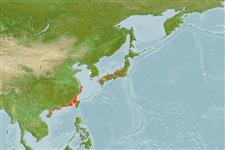Classification / Names
ชื่อสามัญ | ชื่อพ้อง | Catalog of Fishes(สกุล, ชนิด) | ITIS | CoL | WoRMS | Cloffa
>
Blenniiformes (Blennies) >
Blenniidae (Combtooth blennies) > Blenniinae
Etymology: Laiphognathus: Greek, laiphos, -eos = rag, tatter + Greek, gnathos = jaw (Ref. 45335); longispinis: Name from Latin 'longus' for long and 'spina' for spine, refers to the sexually dimorphic elongation of some dorsal spines in males..
Environment: milieu / climate zone / depth range / distribution range
นิเวศวิทยา
เกี่ยวกับทะเล,น้ำเค็ม สัตว์น้ำหน้าดิน; ระดับความลึก 5 - 30 m (Ref. 76746). Temperate
การแพร่กระจาย
ประเทศต่างๆ | พื้นที่จำแนกตาม FAO | ระบบนิเวศหลายระบบ | การปรากฏขึ้น,การเกิดขึ้น,พบ | Point map | การแนะนำ | Faunafri
Northwest Pacific: Japan, Taiwan, HongKong.
ขนาด / น้ำหนัก / Age
Maturity: Lm ? range ? - ? cm
Max length : 5.1 cm SL เพศผู้/กระเทย; (Ref. 76746)
Short description
สัณฐานวิทยา | ความยาวต่างๆ
เงี่ยงครีบหลัง (รวม): 10 - 12; ก้านครีบอ่อนที่หาง (รวม): 20-23; เงี่ยงครีบก้น 2; ก้านครีบอ่อนที่ก้น: 21 - 24; สัตว์มีกระดูกสันหลัง: 38 - 40. This species is distinguished and compared from its congener L. multimaculatus by the following characters: in mature males, 3 to 5 of the 6th-10th dorsal spines elongated (vs. none); anterior and posterior nostrils with 3 and 2 cirri, respectively (vs. 2 or 3 on both nostrils); longest posterior nasal cirrus elongate, 68.4-166.7% of orbit diameter (vs. 18.8-100%); in mature males at least, the lower-lip flap is usually separated into anterior and posterior parts (vs. usually continuous); total dorsal-fin rays 31-34 (vs. 29-32); segmented anal-fin rays 21-24 (vs. 19-22); total vertebrae 38-40 (vs. 35-39); spots on cheek absent (vs. small spots present); usually large, dusky brown body spots forming diagonal bands anteriorly (vs. small spots scattered anteriorly); pectoral-fin base with distinct black spot both centrally and dorsally (vs. inconspicuous spots over entire fin base); belly with elongate black spot, from pelvic-fin base to before anus in mature males and females (wider in males) (vs. circular spot just before anus in males only); in males, abdomen becoming reddish (vs. abdomen not reddish); lips never reddish (becoming reddish at least in mature males) (Ref. 76746).
Adults are reported to occur on rocky slope area and small individuals are known to occur around sea urchins. Oviparous. Eggs are demersal and adhesive (Ref. 205), and are attached to the substrate via a filamentous, adhesive pad or pedestal (Ref. 94114). They lay eggs in a nest, using holes made by invertebrates on massive corals. The well-developed eggs are taken into the mouth and squeezed by the males and the newly hatched larvae swim out of its mouth. Larvae are planktonic, often found in shallow, coastal waters (Ref. 94114). Spawning season extends from the middle of May to the beginning of October in Kinko Bay, Japan (Ref. 76746).
Murase, A., 2007. A new species of the bleniid fish, Laiphognathus longispinis (Perciformes: Bleniidae), from southern Japan and Taiwan. Ichthyol. Res. 54:287-296. (Ref. 76746)
IUCN Red List Status (Ref. 130435)
Threat to humans
Harmless
Human uses
ข้อมูลเพิ่มเติม
ประเทศต่างๆพื้นที่จำแนกตาม FAOระบบนิเวศหลายระบบการปรากฏขึ้น,การเกิดขึ้น,พบการแนะนำStocksนิเวศวิทยาอาหาร, โภชนาการรายการอาหารการบริโภคอาหารอาหารสำหรับสัตว์น้ำแต่ละตัว
Age/SizeการเจริญเติบโตLength-weightLength-lengthLength-frequenciesความยาวต่างๆสัณฐานวิทยาตัวอ่อนพลวัตของสัตว์น้ำวัยอ่อนการทดแทนที่อุดมสมบรูณ์BRUVS
อ้างอิงการเพาะเลี้ยงสัตว์น้ำประวัติการเพาะเลี้ยงสัตว์น้ำสายพันธุ์พันธุศาสตร์ElectrophoresesอัตราพันธุกรรมโรคการแปรรูปNutrientsMass conversion
ผู้ร่วมมือรูปภาพหลายรูปStamps, Coins Misc.เสียงปลามีพิษ เช่น ปลาปักเป้าความเร็วรูปแบบการว่ายน้ำพื้นที่เหงือกOtolithsสมองวิสัยทัศน์
เครื่องมือ
Special reports
Download XML
แหล่งที่มาจากอินเตอร์เน็ต
Estimates based on models
Preferred temperature (Ref.
123201): 19.2 - 26.9, mean 23.7 °C (based on 258 cells).
Phylogenetic diversity index (Ref.
82804): PD
50 = 0.7500 [Uniqueness, from 0.5 = low to 2.0 = high].
Bayesian length-weight: a=0.00562 (0.00258 - 0.01228), b=3.06 (2.87 - 3.25), in cm total length, based on LWR estimates for this (Sub)family-body shape (Ref.
93245).
ระดับชั้นอาหาร (Ref.
69278): 3.3 ±0.4 se; based on size and trophs of closest relatives
ความสามารถในการกลับคืนสู่ปกติ (Ref.
120179): ความสูง, เวลาต่ำสุดที่จะทำให้ประชากรเพิ่มขึ้นเป็น 2 เท่าใช้เวลาน้อยกว่า 15 เดือน (Preliminary K or Fecundity.).
Fishing Vulnerability (Ref.
59153): Low vulnerability (10 of 100).
